HIV/AIDS
| HIV/AIDS | |
|---|---|
| Other names | HIV disease, HIV infection Antiretroviral therapy[4] |
| Prognosis | Near normal life expectancy with treatment[5][6] 11 years life expectancy without treatment[7] |
| Frequency | 64.8 million – 113 million total cases[8] 1.3 million new cases (2022)[8] 39 million living with HIV (2022)[8] |
| Deaths | 40.4 million total deaths[8] 630,000 (2022)[8] |
The human immunodeficiency virus (HIV)[9][10][11] is a retrovirus[12] that attacks the immune system. It can be managed with treatment. Without treatment it can lead to a spectrum of conditions including acquired immunodeficiency syndrome (AIDS).[5]
Effective treatment for HIV-positive people (people living with HIV) involves a life-long regimen of medicine to suppress the virus, making the viral load undetectable. There is no vaccine or cure for HIV. An HIV-positive person on treatment can expect to live a normal life, and die with the virus, not of it.[5][6]
Treatment is recommended as soon as the diagnosis is made.[13]
An HIV-positive person who has an undetectable viral load as a result of long-term treatment has effectively no risk of transmitting HIV sexually.[14][15] Campaigns by UNAIDS and organizations around the world have communicated this as Undetectable = Untransmittable.[16]
Without treatment the infection can interfere with the
HIV is
Ways to avoid catching HIV and
Recognized worldwide in the early 1980s,[20] HIV/AIDS has had a large impact on society, both as an illness and as a source of discrimination.[21] The disease also has large economic impacts.[21] There are many misconceptions about HIV/AIDS, such as the belief that it can be transmitted by casual non-sexual contact.[22] The disease has become subject to many controversies involving religion, including the Catholic Church's position not to support condom use as prevention.[23] It has attracted international medical and political attention as well as large-scale funding since it was identified in the 1980s.[24]
HIV made the jump from other primates to humans in west-central Africa in the early-to-mid-20th century.[25] AIDS was first recognized by the U.S. Centers for Disease Control and Prevention (CDC) in 1981 and its cause—HIV infection—was identified in the early part of the decade.[20] Between the first time AIDS was readily identified through 2021, the disease is estimated to have caused at least 40 million deaths worldwide.[26] In 2021, there were 650,000 deaths and about 38 million people worldwide living with HIV.[8] An estimated 20.6 million of these people live in eastern and southern Africa.[27] HIV/AIDS is considered a pandemic—a disease outbreak which is present over a large area and is actively spreading.[28]
The United States' National Institutes of Health (NIH) and the
Signs and symptoms
There are three main stages of
Acute infection

The initial period following infection with HIV is called acute HIV, primary HIV or acute retroviral syndrome.
These
Clinical latency
The initial symptoms are followed by a stage called clinical latency, asymptomatic HIV, or chronic HIV.[1] Without treatment, this second stage of the natural history of HIV infection can last from about three years[35] to over 20 years[36] (on average, about eight years).[37] While typically there are few or no symptoms at first, near the end of this stage many people experience fever, weight loss, gastrointestinal problems and muscle pains.[1] Between 50% and 70% of people also develop persistent generalized lymphadenopathy, characterized by unexplained, non-painful enlargement of more than one group of lymph nodes (other than in the groin) for over three to six months.[30]
Although most
Acquired immunodeficiency syndrome
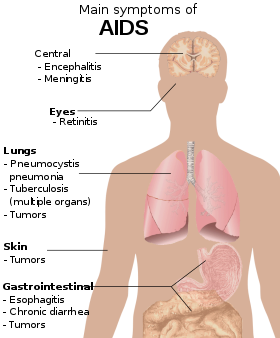
Acquired immunodeficiency syndrome (AIDS) is defined as an HIV infection with either a CD4+ T cell count below 200 cells per µL or the occurrence of specific diseases associated with HIV infection.[33] In the absence of specific treatment, around half of people infected with HIV develop AIDS within ten years.[33] The most common initial conditions that alert to the presence of AIDS are pneumocystis pneumonia (40%), cachexia in the form of HIV wasting syndrome (20%), and esophageal candidiasis.[33] Other common signs include recurrent respiratory tract infections.[33]
People with AIDS have an increased risk of developing various viral-induced cancers, including
Additionally, people with AIDS frequently have systemic symptoms such as prolonged fevers, sweats (particularly at night), swollen lymph nodes, chills, weakness, and unintended weight loss.[44] Diarrhea is another common symptom, present in about 90% of people with AIDS.[45] They can also be affected by diverse psychiatric and neurological symptoms independent of opportunistic infections and cancers.[46]
Transmission
| Exposure route | Chance of infection | |||
|---|---|---|---|---|
| Blood transfusion | 90%[47] | |||
| Childbirth (to child) | 25%[48][clarification needed] | |||
| Needle-sharing injection drug use | 0.67%[49] | |||
| Percutaneous needle stick | 0.30%[50] | |||
| Receptive anal intercourse* | 0.04–3.0%[51] | |||
| Insertive anal intercourse* | 0.03%[52] | |||
| Receptive penile-vaginal intercourse* | 0.05–0.30%[51][53] | |||
| Insertive penile-vaginal intercourse* | 0.01–0.38%[51][53] | |||
| Receptive oral intercourse*§ | 0–0.04%[51] | |||
| Insertive oral intercourse*§ | 0–0.005%[54] | |||
| * assuming no condom use § source refers to oral intercourse performed on a man | ||||
HIV is spread by three main routes: sexual contact, significant exposure to infected body fluids or tissues, and from mother to child during pregnancy, delivery, or breastfeeding (known as vertical transmission).[17] There is no risk of acquiring HIV if exposed to feces, nasal secretions, saliva, sputum, sweat, tears, urine, or vomit unless these are contaminated with blood.[55] It is also possible to be co-infected by more than one strain of HIV—a condition known as HIV superinfection.[56]
Sexual
The most frequent mode of transmission of HIV is through sexual contact with an infected person.[17] However, an HIV-positive person who has an undetectable viral load as a result of long-term treatment has effectively no risk of transmitting HIV sexually.[14][15] The existence of functionally noncontagious HIV-positive people on antiretroviral therapy was controversially publicized in the 2008 Swiss Statement, and has since become accepted as medically sound.[57]
Globally, the most common mode of HIV transmission is via
With regard to
Risk of transmission increases in the presence of many
The viral load of an infected person is an important risk factor in both sexual and mother-to-child transmission.[68] During the first 2.5 months of an HIV infection a person's infectiousness is twelve times higher due to the high viral load associated with acute HIV.[66] If the person is in the late stages of infection, rates of transmission are approximately eightfold greater.[61]
Commercial sex workers (including those in pornography) have an increased likelihood of contracting HIV.[69][70] Rough sex can be a factor associated with an increased risk of transmission.[71] Sexual assault is also believed to carry an increased risk of HIV transmission as condoms are rarely worn, physical trauma to the vagina or rectum is likely, and there may be a greater risk of concurrent sexually transmitted infections.[72]
Body fluids

The second-most frequent mode of HIV transmission is via blood and blood products.[17] Blood-borne transmission can be through needle-sharing during intravenous drug use, needle-stick injury, transfusion of contaminated blood or blood product, or medical injections with unsterilized equipment. The risk from sharing a needle during drug injection is between 0.63% and 2.4% per act, with an average of 0.8%.[73] The risk of acquiring HIV from a needle stick from an HIV-infected person is estimated as 0.3% (about 1 in 333) per act and the risk following mucous membrane exposure to infected blood as 0.09% (about 1 in 1000) per act.[55] This risk may, however, be up to 5% if the introduced blood was from a person with a high viral load and the cut was deep.[74] In the United States, intravenous drug users made up 12% of all new cases of HIV in 2009,[75] and in some areas more than 80% of people who inject drugs are HIV-positive.[17]
HIV is transmitted in about 90% of
Unsafe medical injections play a role in HIV spread in sub-Saharan Africa. In 2007, between 12% and 17% of infections in this region were attributed to medical syringe use.[81] The World Health Organization estimates the risk of transmission as a result of a medical injection in Africa at 1.2%.[81] Risks are also associated with invasive procedures, assisted delivery, and dental care in this area of the world.[81]
People giving or receiving tattoos, piercings, and scarification are theoretically at risk of infection but no confirmed cases have been documented.[82] It is not possible for mosquitoes or other insects to transmit HIV.[83]
Mother-to-child
HIV can be transmitted from mother to child during pregnancy, during delivery, or through breast milk, resulting in the baby also contracting HIV.[17][84] As of 2008, vertical transmission accounted for about 90% of cases of HIV in children.[85] In the absence of treatment, the risk of transmission before or during birth is around 20%, and in those who also breastfeed 35%.[85] Treatment decreases this risk to less than 5%.[86]
Antiretrovirals when taken by either the mother or the baby decrease the risk of transmission in those who do breastfeed.
Virology

HIV is the cause of the spectrum of disease known as HIV/AIDS. HIV is a retrovirus that primarily infects components of the human immune system such as CD4+ T cells, macrophages and dendritic cells. It directly and indirectly destroys CD4+ T cells.[89]
HIV is a member of the
HIV is now known to spread between CD4+ T cells by two parallel routes: cell-free spread and cell-to-cell spread, i.e. it employs hybrid spreading mechanisms.[96] In the cell-free spread, virus particles bud from an infected T cell, enter the blood/extracellular fluid and then infect another T cell following a chance encounter.[96] HIV can also disseminate by direct transmission from one cell to another by a process of cell-to-cell spread.[97][98] The hybrid spreading mechanisms of HIV contribute to the virus' ongoing replication against antiretroviral therapies.[96][99]
Two
Pathophysiology
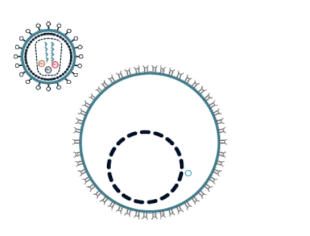
After the virus enters the body, there is a period of rapid viral replication, leading to an abundance of virus in the peripheral blood. During primary infection, the level of HIV may reach several million virus particles per milliliter of blood.[102] This response is accompanied by a marked drop in the number of circulating CD4+ T cells. The acute viremia is almost invariably associated with activation of CD8+ T cells, which kill HIV-infected cells, and subsequently with antibody production, or seroconversion. The CD8+ T cell response is thought to be important in controlling virus levels, which peak and then decline, as the CD4+ T cell counts recover. A good CD8+ T cell response has been linked to slower disease progression and a better prognosis, though it does not eliminate the virus.[103]
Ultimately, HIV causes AIDS by depleting CD4+ T cells. This weakens the immune system and allows opportunistic infections. T cells are essential to the immune response and without them, the body cannot fight infections or kill cancerous cells. The mechanism of CD4+ T cell depletion differs in the acute and chronic phases.[104] During the acute phase, HIV-induced cell lysis and killing of infected cells by CD8+ T cells accounts for CD4+ T cell depletion, although apoptosis may also be a factor. During the chronic phase, the consequences of generalized immune activation coupled with the gradual loss of the ability of the immune system to generate new T cells appear to account for the slow decline in CD4+ T cell numbers.[105]
Although the symptoms of immune deficiency characteristic of AIDS do not appear for years after a person is infected, the bulk of CD4+ T cell loss occurs during the first weeks of infection, especially in the intestinal mucosa, which harbors the majority of the lymphocytes found in the body.
HIV seeks out and destroys CCR5 expressing CD4+ T cells during acute infection.[109] A vigorous immune response eventually controls the infection and initiates the clinically latent phase. CD4+ T cells in mucosal tissues remain particularly affected.[109] Continuous HIV replication causes a state of generalized immune activation persisting throughout the chronic phase.[110] Immune activation, which is reflected by the increased activation state of immune cells and release of pro-inflammatory cytokines, results from the activity of several HIV gene products and the immune response to ongoing HIV replication. It is also linked to the breakdown of the immune surveillance system of the gastrointestinal mucosal barrier caused by the depletion of mucosal CD4+ T cells during the acute phase of disease.[111]
Diagnosis

| Blood test | Days |
|---|---|
| Antibody test (rapid test, ELISA 3rd gen) | 23–90 |
| Antibody and p24 antigen test (ELISA 4th gen) | 18–45 |
| PCR | 10–33 |
HIV/AIDS is diagnosed via laboratory testing and then staged based on the presence of
HIV testing
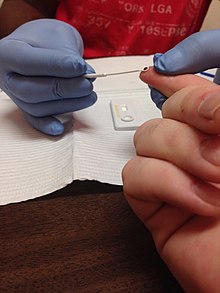

Most people infected with HIV develop
Antibody tests in children younger than 18 months are typically inaccurate, due to the continued presence of
Classifications
Two main clinical staging systems are used to classify HIV and HIV-related disease for surveillance purposes: the WHO disease staging system for HIV infection and disease,[31] and the CDC classification system for HIV infection.[116] The CDC's classification system is more frequently adopted in developed countries. Since the WHO's staging system does not require laboratory tests, it is suited to the resource-restricted conditions encountered in developing countries, where it can also be used to help guide clinical management. Despite their differences, the two systems allow a comparison for statistical purposes.[30][31][116]
The World Health Organization first proposed a definition for AIDS in 1986.[31] Since then, the WHO classification has been updated and expanded several times, with the most recent version being published in 2007.[31] The WHO system uses the following categories:
- Primary HIV infection: May be either asymptomatic or associated with acute retroviral syndrome[31]
- Stage I: HIV infection is asymptomatic with a CD4+ T cell count (also known as CD4 count) greater than 500 per microlitre (µl or cubic mm) of blood.[31] May include generalized lymph node enlargement.[31]
- Stage II: Mild symptoms, which may include minor mucocutaneous manifestations and recurrent upper respiratory tract infections. A CD4 count of less than 500/µl[31]
- Stage III: Advanced symptoms, which may include unexplained chronic diarrhea for longer than a month, severe bacterial infections including tuberculosis of the lung, and a CD4 count of less than 350/µl[31]
- Stage IV or AIDS: severe symptoms, which include
The U.S. Centers for Disease Control and Prevention also created a classification system for HIV, and updated it in 2008 and 2014.[116][117] This system classifies HIV infections based on CD4 count and clinical symptoms, and describes the infection in five groups.[117] In those greater than six years of age it is:[117]
- Stage 0: the time between a negative or indeterminate HIV test followed less than 180 days by a positive test
- Stage 1: CD4 count ≥ 500 cells/µl and no AIDS-defining conditions
- Stage 2: CD4 count 200 to 500 cells/µl and no AIDS-defining conditions
- Stage 3: CD4 count ≤ 200 cells/µl or AIDS-defining conditions
- Unknown: if insufficient information is available to make any of the above classifications.
For surveillance purposes, the AIDS diagnosis still stands even if, after treatment, the CD4+ T cell count rises to above 200 per µL of blood or other AIDS-defining illnesses are cured.[30]
Prevention
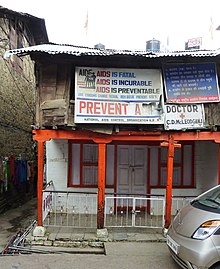
Sexual contact
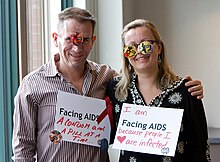
Consistent
Programs encouraging sexual abstinence do not appear to affect subsequent HIV risk.[130] Evidence of any benefit from peer education is equally poor.[131] Comprehensive sexual education provided at school may decrease high-risk behavior.[132][133] A substantial minority of young people continues to engage in high-risk practices despite knowing about HIV/AIDS, underestimating their own risk of becoming infected with HIV.[134] Voluntary counseling and testing people for HIV does not affect risky behavior in those who test negative but does increase condom use in those who test positive.[135] Enhanced family planning services appear to increase the likelihood of women with HIV using contraception, compared to basic services.[136] It is not known whether treating other sexually transmitted infections is effective in preventing HIV.[67]
Pre-exposure
Antiretroviral treatment among people with HIV whose CD4 count ≤ 550 cells/µL is a very effective way to prevent HIV infection of their partner (a strategy known as treatment as prevention, or TASP).
Post-exposure
A course of antiretrovirals administered within 48 to 72 hours after exposure to HIV-positive blood or genital secretions is referred to as
PEP treatment is recommended after a sexual assault when the perpetrator is known to be HIV-positive, but is controversial when their HIV status is unknown.[147] The duration of treatment is usually four weeks[148] and is frequently associated with adverse effects—where zidovudine is used, about 70% of cases result in adverse effects such as nausea (24%), fatigue (22%), emotional distress (13%) and headaches (9%).[55]
Mother-to-child
Programs to prevent the
Vaccination
Currently there is no licensed vaccine for HIV or AIDS.[6] The most effective vaccine trial to date, RV 144, was published in 2009; it found a partial reduction in the risk of transmission of roughly 30%, stimulating some hope in the research community of developing a truly effective vaccine.[153]
Treatment
There is currently no cure, nor an effective HIV vaccine. Treatment consists of
Antiviral therapy
Current ART options are combinations (or "cocktails") consisting of at least three medications belonging to at least two types, or "classes", of
The World Health Organization and the United States recommend antiretrovirals in people of all ages (including pregnant women) as soon as the diagnosis is made, regardless of CD4 count.[13][163][164] Once treatment is begun, it is recommended that it is continued without breaks or "holidays".[34] Many people are diagnosed only after treatment ideally should have begun.[34] The desired outcome of treatment is a long-term plasma HIV-RNA count below 50 copies/mL.[34] Levels to determine if treatment is effective are initially recommended after four weeks and once levels fall below 50 copies/mL checks every three to six months are typically adequate.[34] Inadequate control is deemed to be greater than 400 copies/mL.[34] Based on these criteria treatment is effective in more than 95% of people during the first year.[34]
Benefits of treatment include a decreased risk of progression to AIDS and a decreased risk of death.
Specific adverse events are related to the antiretroviral agent taken.
Treatment recommendations for children are somewhat different from those for adults. The World Health Organization recommends treating all children less than five years of age; children above five are treated like adults.[177] The United States guidelines recommend treating all children less than 12 months of age and all those with HIV RNA counts greater than 100,000 copies/mL between one year and five years of age.[178]
The European Medicines Agency (EMA) has recommended the granting of marketing authorizations for two new antiretroviral (ARV) medicines, rilpivirine (Rekambys) and cabotegravir (Vocabria), to be used together for the treatment of people with human immunodeficiency virus type 1 (HIV-1) infection.[179] The two medicines are the first ARVs that come in a long-acting injectable formulation.[179] This means that instead of daily pills, people receive intramuscular injections monthly or every two months.[179]
The combination of Rekambys and Vocabria injection is intended for maintenance treatment of adults who have undetectable HIV levels in the blood (viral load less than 50 copies/ml) with their current ARV treatment, and when the virus has not developed resistance to a certain class of anti-HIV medicines called non-nucleoside reverse transcriptase inhibitors (NNRTIs) and integrase strand transfer inhibitors (INIs).[179]
Cabotegravir combined with rilpivirine (Cabenuva) is a complete regimen for the treatment of human immunodeficiency virus type 1 (HIV-1) infection in adults to replace a current antiretroviral regimen in those who are virologically suppressed on a stable antiretroviral regimen with no history of treatment failure and with no known or suspected resistance to either cabotegravir or rilpivirine.[180][181]
Opportunistic infections
Measures to prevent opportunistic infections are effective in many people with HIV/AIDS. In addition to improving current disease, treatment with antiretrovirals reduces the risk of developing additional opportunistic infections.[174]
Adults and adolescents who are living with HIV (even on anti-retroviral therapy) with no evidence of active tuberculosis in settings with high tuberculosis burden should receive isoniazid preventive therapy (IPT); the tuberculin skin test can be used to help decide if IPT is needed.[182] Children with HIV may benefit from screening for tuberculosis.[183] Vaccination against hepatitis A and B is advised for all people at risk of HIV before they become infected; however, it may also be given after infection.[184]
Diet
The World Health Organization (WHO) has issued recommendations regarding nutrient requirements in HIV/AIDS.[191] A generally healthy diet is promoted. Dietary intake of micronutrients at RDA levels by HIV-infected adults is recommended by the WHO; higher intake of vitamin A, zinc, and iron can produce adverse effects in HIV-positive adults, and is not recommended unless there is documented deficiency.[191][192][193][194] Dietary supplementation for people who are infected with HIV and who have inadequate nutrition or dietary deficiencies may strengthen their immune systems or help them recover from infections; however, evidence indicating an overall benefit in morbidity or reduction in mortality is not consistent.[195]
People with HIV/AIDS are up to four times more likely to develop type 2 diabetes than those who are not tested positive with the virus.[196]
Evidence for supplementation with selenium is mixed with some tentative evidence of benefit.[197] For pregnant and lactating women with HIV, multivitamin supplement improves outcomes for both mothers and children.[198] If the pregnant or lactating mother has been advised to take anti-retroviral medication to prevent mother-to-child HIV transmission, multivitamin supplements should not replace these treatments.[198] There is some evidence that vitamin A supplementation in children with an HIV infection reduces mortality and improves growth.[199]
Alternative medicine
In the US, approximately 60% of people with HIV use various forms of complementary or alternative medicine,[200] whose effectiveness has not been established.[201] There is not enough evidence to support the use of herbal medicines.[202] There is insufficient evidence to recommend or support the use of medical cannabis to try to increase appetite or weight gain.[203]
Prognosis

HIV/AIDS has become a
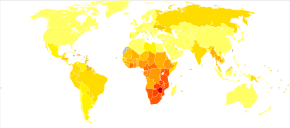
| no data ≤ 10 10–25 25–50 50–100 | 100–500 500–1000 1,000–2,500 2,500–5,000 5,000–7500 | 7,500–10,000 10,000–50,000 ≥ 50,000 |
The primary causes of death from HIV/AIDS are
Even with anti-retroviral treatment, over the long term HIV-infected people may experience
Epidemiology
Graphs are unavailable due to technical issues. There is more info on Phabricator and on MediaWiki.org. |

HIV/AIDS is considered a global pandemic.[227] As of 2022[update], approximately 39.0 million people worldwide are living with HIV, the number of new infections that year being about 1.3 million.[155] This is down from 2.1 million new infections in 2010.[155] Among new infections, 46% are in women and are children globally.[155] There were 630,000 AIDS related deaths in 2022, down from a peak of 2 million in 2005.[155]
Among persons living with HIV (PLWH), the largest proportion reside in eastern and southern Africa (20.6 million, 54.6%). This region also had the highest rate of adult and child deaths due to AIDS in 2020 (310,000, 46.6%). Sub-Saharan African adolescent girls and young women (aged 15–24 years) account for 77% of new infections among this age-range globally [155] Here, in contrast to other regions, adolescent girls and young women are three times more likely to acquire HIV than age-matched males.[155] Despite these statistics, overall, new HIV infections and AIDS-related deaths have substantially decreased in this region since 2010.[228]
Eastern Europe and central Asia has observed a 43% increase in new HIV infections and 32% increase in AIDS-related deaths since 2010, the highest of all global regions.[228] These infections are predominantly distributed in persons who inject drugs, with gay men and other men who have sex with men or persons who engage in transaction sex the second and third populations most impacted in this region.[228]
At the end of 2019, United States indicated that approximately 1.2 million people aged ≥13 years were living with HIV, resulting in about 18,500 deaths in 2020.[229] There were 34,800 estimated new infections in the US in 2019, 53% of which were in the southern region of the country.[229] In addition to geographic location, significant disparities in HIV incidence exist among men, Black or Hispanic populations, and men who reported male-to-male sexual contact. The US Centers for Disease Control and Prevention estimated that in that year, 158,500 people or 13% of infected Americans were unaware of their infection.[229]
In the United Kingdom as of 2015[update], there were approximately 101,200 cases which resulted in 594 deaths.[230] In Canada as of 2008, there were about 65,000 cases causing 53 deaths.[231] Between the first recognition of AIDS (in 1981) and 2009, it has led to nearly 30 million deaths.[232] Rates of HIV are lowest in North Africa and the Middle East (0.1% or less), East Asia (0.1%), and Western and Central Europe (0.2%).[233] The worst-affected European countries, in 2009 and 2012 estimates, are Russia, Ukraine, Latvia, Moldova, Portugal and Belarus, in decreasing order of prevalence.[234]
Groups at higher risk of acquiring HIV include persons who engage in transactional sex, gay men and other men who have sex with men, persons who inject drugs, transgender persons, and those who are incarcerated or detained.[155]
History
Discovery
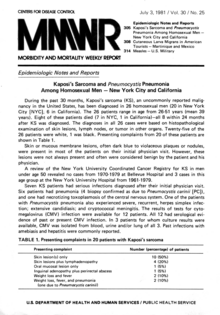
The first news story on the disease appeared on May 18, 1981, in the gay newspaper
In the early days, the CDC did not have an official name for the disease, often referring to it by way of diseases associated with it, such as
In 1983, two separate research groups led by
Origins
The origin of HIV / AIDS and the circumstances that led to its emergence remain unsolved.[252]
Both HIV-1 and HIV-2 are believed to have originated in non-human
There is evidence that humans who participate in bushmeat activities, either as hunters or as bushmeat vendors, commonly acquire SIV.[257] However, SIV is a weak virus which is typically suppressed by the human immune system within weeks of infection. It is thought that several transmissions of the virus from individual to individual in quick succession are necessary to allow it enough time to mutate into HIV.[258] Furthermore, due to its relatively low person-to-person transmission rate, SIV can only spread throughout the population in the presence of one or more high-risk transmission channels, which are thought to have been absent in Africa before the 20th century.[259]
Specific proposed high-risk transmission channels, allowing the virus to adapt to humans and spread throughout society, depend on the proposed timing of the animal-to-human crossing. Genetic studies of the virus suggest that the most recent common ancestor of the HIV-1 M group dates back to c. 1910.
An alternative view holds that unsafe medical practices in Africa after World War II, such as unsterile reuse of single-use syringes during mass vaccination, antibiotic and anti-malaria treatment campaigns, were the initial vector that allowed the virus to adapt to humans and spread.[258][262][263]
The earliest well-documented case of HIV in a human dates back to 1959 in the Congo.[264] The virus may have been present in the U.S. as early as the mid-to-late 1950s, as a sixteen-year-old male named Robert Rayford presented with symptoms in 1966 and died in 1969. In the 1970s, there were cases of getting parasites and becoming sick with what was called "gay bowel disease", but what is now suspected to have been AIDS.[265]
The earliest retrospectively described case of AIDS is believed to have been in Norway beginning in 1966, that of Arvid Noe.[266] In July 1960, in the wake of Congo's independence, the United Nations recruited Francophone experts and technicians from all over the world to assist in filling administrative gaps left by Belgium, who did not leave behind an African elite to run the country. By 1962, Haitians made up the second-largest group of well-educated experts (out of the 48 national groups recruited), that totaled around 4500 in the country.[267][268] Dr. Jacques Pépin, a Canadian author of The Origins of AIDS, stipulates that Haiti was one of HIV's entry points to the U.S. and that a Haitian may have carried HIV back across the Atlantic in the 1960s.[268] Although there was known to have been at least one case of AIDS in the U.S. from 1966,[269] the vast majority of infections occurring outside sub-Saharan Africa (including the U.S.) can be traced back to a single unknown individual who became infected with HIV in Haiti and brought the infection to the U.S. at some time around 1969.[252] The epidemic rapidly spread among high-risk groups (initially, sexually promiscuous men who have sex with men). By 1978, the prevalence of HIV-1 among gay male residents of New York City and San Francisco was estimated at 5%, suggesting that several thousand individuals in the country had been infected.[252]
Society and culture
Stigma

AIDS stigma exists around the world in a variety of ways, including ostracism, rejection, discrimination and avoidance of HIV-infected people; compulsory HIV testing without prior consent or protection of confidentiality; violence against HIV-infected individuals or people who are perceived to be infected with HIV; and the quarantine of HIV-infected individuals.[21] Stigma-related violence or the fear of violence prevents many people from seeking HIV testing, returning for their results, or securing treatment, possibly turning what could be a manageable chronic illness into a death sentence and perpetuating the spread of HIV.[271]
AIDS stigma has been further divided into the following three categories:
- Instrumental AIDS stigma—a reflection of the fear and apprehension that are likely to be associated with any deadly and transmissible illness.[272]
- Symbolic AIDS stigma—the use of HIV/AIDS to express attitudes toward the social groups or lifestyles perceived to be associated with the disease.[272]
- Courtesy AIDS stigma—stigmatization of people connected to the issue of HIV/AIDS or HIV-positive people.[273]
Often, AIDS stigma is expressed in conjunction with one or more other stigmas, particularly those associated with homosexuality,
In many
In 2003, as part of an overall reform of marriage and population legislation, it became legal for those diagnosed with AIDS to marry in China.[277]
In 2013, the
Economic impact
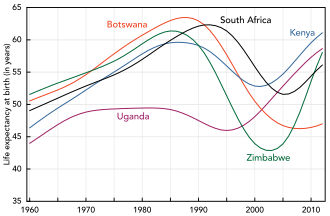
HIV/AIDS affects the economics of both individuals and countries.[280] The gross domestic product of the most affected countries has decreased due to the lack of human capital.[280][281] Without proper nutrition, health care and medicine, large numbers of people die from AIDS-related complications. Before death they will not only be unable to work, but will also require significant medical care. It is estimated that as of 2007 there were 12 million AIDS orphans.[280] Many are cared for by elderly grandparents.[282]
Returning to work after beginning treatment for HIV/AIDS is difficult, and affected people often work less than the average worker. Unemployment in people with HIV/AIDS also is associated with suicidal ideation, memory problems, and social isolation. Employment increases self-esteem, sense of dignity, confidence, and quality of life for people with HIV/AIDS. Anti-retroviral treatment may help people with HIV/AIDS work more, and may increase the chance that a person with HIV/AIDS will be employed (low-quality evidence).[283]
By affecting mainly young adults, AIDS reduces the taxable population, in turn reducing the resources available for public expenditures such as education and health services not related to AIDS, resulting in increasing pressure on the state's finances and slower growth of the economy. This causes a slower growth of the tax base, an effect that is reinforced if there are growing expenditures on treating the sick, training (to replace sick workers), sick pay, and caring for AIDS orphans. This is especially true if the sharp increase in adult mortality shifts the responsibility from the family to the government in caring for these orphans.[282]
At the household level, AIDS causes both loss of income and increased spending on healthcare. A study in
Religion and AIDS
The topic of religion and AIDS has become highly controversial, primarily because some religious authorities have publicly declared their opposition to the use of condoms.[285][286] The religious approach to prevent the spread of AIDS, according to a report by American health expert Matthew Hanley titled The Catholic Church and the Global AIDS Crisis, argues that cultural changes are needed, including a re-emphasis on fidelity within marriage and sexual abstinence outside of it.[286]
Some religious organizations have claimed that prayer can cure HIV/AIDS. In 2011, the BBC reported that some churches in London were claiming that prayer would cure AIDS, and the
Media portrayal
One of the first high-profile cases of AIDS was the American gay actor Rock Hudson. He had been diagnosed during 1984, announced that he had had the virus on July 25, 1985, and died a few months later on October 2, 1985.[288] Another notable British casualty of AIDS that year was Nicholas Eden, a gay politician and son of former prime minister Anthony Eden.[289] On November 24, 1991, British rock star Freddie Mercury died from an AIDS-related illness, having revealed the diagnosis only on the previous day.[290]
One of the first high-profile heterosexual cases of the virus was American tennis player Arthur Ashe. He was diagnosed as HIV-positive on August 31, 1988, having contracted the virus from blood transfusions during heart surgery earlier in the 1980s. Further tests within 24 hours of the initial diagnosis revealed that Ashe had AIDS, but he did not tell the public about his diagnosis until April 1992.[291] He died as a result on February 6, 1993, aged 49.[292]
Therese Frare's photograph of gay activist
Many famous artists and AIDS activists such as Larry Kramer, Diamanda Galás and Rosa von Praunheim[294] campaign for AIDS education and the rights of those affected. These artists worked with various media formats.
Criminal transmission
Criminal transmission of HIV is the
In 1996, Ugandan-born Canadian
Misconceptions
There are many
A small group of individuals continue to dispute the connection between HIV and AIDS,
Several discredited
Research
HIV/AIDS research includes all medical research which attempts to prevent, treat, or cure HIV/AIDS, along with fundamental research about the nature of HIV as an infectious agent, and about AIDS as the disease caused by HIV.
Many governments and research institutions participate in HIV/AIDS research. This research includes behavioral
References
- ^ a b c d "What Are HIV and AIDS?". HIV.gov. May 15, 2017. Archived from the original on September 22, 2019. Retrieved September 10, 2017.
- ^ "HIV Classification: CDC and WHO Staging Systems". AIDS Education & Training Center Program. Archived from the original on October 18, 2017. Retrieved September 10, 2017.
- UNAIDS. Archivedfrom the original on September 10, 2017. Retrieved September 10, 2017.
- ^ a b c d e f g h i j k l m "HIV/AIDS Fact sheet N°360". World Health Organization. November 2015. Archived from the original on February 17, 2016. Retrieved February 11, 2016.
- ^ a b c d e f "About HIV/AIDS". U.S. Centers for Disease Control and Prevention (CDC). December 6, 2015. Archived from the original on February 24, 2016. Retrieved February 11, 2016.
- ^ a b c d UNAIDS (May 18, 2012). "The quest for an HIV vaccine". Archived from the original on May 24, 2012.
- ^ a b c UNAIDS, World Health Organization (December 2007). "2007 AIDS epidemic update" (PDF). Archived from the original (PDF) on May 27, 2008. Retrieved March 12, 2008.
- ^ UNAIDS. Archivedfrom the original on December 4, 2019. Retrieved July 20, 2023.
- PMID 11396444.
- ISBN 978-0-387-93835-6. Archivedfrom the original on September 24, 2015. Retrieved June 27, 2015.
- ISBN 978-1-4020-5613-0. Archivedfrom the original on September 11, 2015. Retrieved June 27, 2015.
- ^ "Retrovirus Definition". AIDSinfo. Archived from the original on December 28, 2019. Retrieved December 28, 2019.
- ^ ISBN 978-92-4-150956-5. Archived(PDF) from the original on October 14, 2015.
- ^ a b McCray E, Mermin J (September 27, 2017). "Dear Colleague: September 27, 2017". U.S. Centers for Disease Control and Prevention (CDC). Archived from the original on January 30, 2018. Retrieved February 1, 2018.
- ^ PMID 30455270.
- UNAIDS. Archivedfrom the original on December 11, 2023. Retrieved August 26, 2022.
- ^ ISBN 978-0-7817-6299-1. Archivedfrom the original on September 11, 2015. Retrieved June 27, 2015.
- ^ "HIV and Its Transmission". U.S. Centers for Disease Control and Prevention (CDC). 2003. Archived from the original on February 4, 2005. Retrieved May 23, 2006.
- ^ "Preventing Sexual Transmission of HIV". HIV.gov. April 9, 2021. Archived from the original on February 1, 2022. Retrieved February 1, 2022.
- ^ PMID 17054781.
- ^ ISBN 978-92-9173-479-5. Archived(PDF) from the original on October 4, 2006. Retrieved June 16, 2006.
- from the original on February 22, 2016. Retrieved February 14, 2016.
- ^ McCullom R (February 26, 2013). "An African Pope Won't Change the Vatican's Views on Condoms and AIDS". The Atlantic. Archived from the original on March 8, 2016. Retrieved February 14, 2016.
- ISBN 978-1-59797-294-9.
- ^ PMID 22229120.
- ^ "HIV Statistics Overview (International Statistics)". U.S. Centers for Disease Control and Prevention (CDC). 2018. Archived from the original on December 7, 2018. Retrieved May 9, 2021.
- UNAIDS. Archived(PDF) from the original on December 21, 2019. Retrieved December 21, 2019.
- S2CID 205339589.(subscription required)
- ^ "NIH launches new collaboration to develop gene-based cures for sickle cell disease and HIV on global scale". National Institutes of Health (NIH). October 23, 2019. Archived from the original on September 4, 2021. Retrieved September 24, 2021.
- ^ a b c d e f Mandell, Bennett, and Dolan (2010). Chapter 121.
- ^ ISBN 978-92-4-159562-9. Archived(PDF) from the original on October 31, 2013.
- ISBN 978-0-7614-7771-6. Archivedfrom the original on September 19, 2015. Retrieved June 27, 2015.
- ^ a b c d e f g h i j k l m n o Mandell, Bennett, and Dolan (2010). Chapter 118.
- ^ PMID 20703338.
- ISBN 978-1-77009-198-6. Archivedfrom the original on September 11, 2015. Retrieved June 27, 2015.
- ISBN 978-3-540-66510-6. Archivedfrom the original on May 9, 2016. Retrieved June 27, 2015.
- ISBN 978-1-118-37226-5. Archivedfrom the original on September 19, 2015. Retrieved June 27, 2015.
- ^ PMID 20350494.
- PMID 17720999.
- PMID 12594648.
- PMID 21322514.
- ^ a b c d e Mandell, Bennett, and Dolan (2010). Chapter 169.
- PMID 24227983.
- ^ "AIDS". MedlinePlus. Archived from the original on June 18, 2012. Retrieved June 14, 2012.
- PMID 16022653.
- ISBN 978-1-4377-0434-1.
- ^ . Retrieved May 11, 2020.
- PMID 15247337.
- PMID 15660015.
- PMID 17708137.
- ^ PMID 20543603.
- ISBN 9781449693831.
- ^ PMID 19179227.
- PMID 18664564.
- ^ PMID 17708137.
- PMID 17892568.
- PMID 26824882.
- ^ "HIV and Men". U.S. Centers for Disease Control and Prevention (CDC). Archived from the original on December 1, 2019. Retrieved November 3, 2019.
- ^ "HIV and Gay and Bisexual Men". U.S. Centers for Disease Control and Prevention (CDC). Archived from the original on November 2, 2019. Retrieved November 3, 2019.
- ^ "HIV Among Gay and Bisexual Men" (PDF). Archived (PDF) from the original on December 18, 2016. Retrieved January 1, 2017.
- ^ PMID 19179227.
- PMID 22819660.
- PMID 20624114.
- ISBN 978-1-55581-376-5. Archivedfrom the original on November 30, 2015. Retrieved June 27, 2015.
- ISBN 978-0-19-957166-6.
- ^ S2CID 25541753.
- ^ PMID 21412869.
- S2CID 6198083.
- ISBN 978-0-8213-9775-6. Archivedfrom the original on September 19, 2015. Retrieved June 27, 2015.
- ISBN 978-1-4614-4526-5. Archivedfrom the original on September 24, 2015. Retrieved June 27, 2015.
- S2CID 38476611.
- S2CID 205771853.
- S2CID 22674060.
- ^ "Needlestick Prevention Guide" (PDF). 2002. pp. 5–6. Archived (PDF) from the original on July 12, 2018. Retrieved November 10, 2019.
- ^ "HIV in the United States: An Overview". Center for Disease Control and Prevention. March 2012. Archived from the original on May 1, 2013.
- ^ "Will I need a blood transfusion?" (PDF). National Health Services. 2011. Archived (PDF) from the original on October 25, 2012. Retrieved August 29, 2012.
- PMID 20966896.
- ^ UNAIDS 2011 pg. 60–70
- ^ "Blood safety ... for too few". World Health Organization. 2001. Archived from the original on January 17, 2005.
- from the original on October 6, 2020. Retrieved October 16, 2019.
- ^ PMID 19715601.
- ^ a b "Basic Information about HIV and AIDS". Center for Disease Control and Prevention. April 2012. Archived from the original on June 18, 2017.
- ^ Crans WJ (June 1, 2010). "Why Mosquitoes Cannot Transmit AIDS". Rutgers University. New Jersey Agricultural Experiment Station Publication No. H-40101-01-93. Archived from the original on March 29, 2014. Retrieved March 29, 2014.
- ^ "Preventing Mother-to-Child Transmission of HIV". HIV.gov. Archived from the original on December 9, 2017. Retrieved December 8, 2017.
- ^ S2CID 46624541.
- ^ "Mother-to-child transmission of HIV". World Health Organization. Archived from the original on October 18, 2019. Retrieved December 27, 2019.
- PMID 25280769.
- ^ a b c "Infant feeding in the context of HIV". World Health Organization. April 2011. Archived from the original on March 9, 2017. Retrieved March 9, 2017.
- PMID 12810858.
- ^ International Committee on Taxonomy of Viruses (2002). "61.0.6. Lentivirus". Men's Journal. National Institutes of Health. Archived from the original on April 18, 2006. Retrieved June 25, 2012.
- ^ International Committee on Taxonomy of Viruses (2002). "61. Retroviridae". Men's Journal. National Institutes of Health. Archived from the original on December 17, 2001. Retrieved June 25, 2012.
- PMID 8280406.
- PMID 17163676.
- ISBN 978-1-904455-56-1. Archivedfrom the original on September 11, 2015. Retrieved June 27, 2015.
- ISBN 978-1-55581-246-1. Archivedfrom the original on May 9, 2016. Retrieved June 27, 2015.
- ^ PMID 25837979.
- PMID 14734528.
- S2CID 20991705.
- S2CID 4409389.
- S2CID 28523977.
- ^ PMID 12029140.
- S2CID 12158927.
- PMID 8990195.
- PMID 16679064.
- ISBN 978-0-470-51799-4.
- PMID 15365095.
- PMID 15365096.
- PMID 19339948.
- ^ ISBN 978-1-4614-0483-5. Archivedfrom the original on September 24, 2015. Retrieved June 27, 2015.
- S2CID 26830006.
- PMID 17115046.
- ^ "HIV/AIDS Testing". U.S. Centers for Disease Control and Prevention (CDC). March 16, 2018. Archived from the original on April 14, 2018. Retrieved April 14, 2018.
- ^ PMID 31184701.
- ^ PMID 20652012.
- ^ a b c UNAIDS 2011 pg. 70–80
- ^ (PDF) from the original on October 17, 2020. Retrieved October 17, 2020.
- ^ (PDF) from the original on October 17, 2020. Retrieved October 17, 2020.
- PMID 22348628.
- ^ "Condom Facts and Figures". World Health Organization. August 2003. Archived from the original on October 18, 2012. Retrieved January 17, 2006.
- from the original on October 28, 2021. Retrieved September 4, 2020.
- ^ PMID 22156901.
- PMID 20205637.
- PMID 19370585.
- ^ "WHO and UNAIDS announce recommendations from expert consultation on male circumcision for HIV prevention". World Health Organization. March 28, 2007. Archived from the original on July 3, 2011.
- PMID 20622758.
- PMID 19849961.(subscription required)
- S2CID 2158164.
- S2CID 43878584.
- PMID 21678366.
- PMID 17943855. Archived from the originalon November 25, 2010. Retrieved May 31, 2012.
- PMID 22641791.
- PMID 21251451.
- ISBN 978-92-3-100259-5. Archived(PDF) from the original on November 13, 2018. Retrieved February 22, 2018.
- PMID 18724961.
- PMID 22972050.
- PMID 27505053.
- ^ PMID 23633367.
- S2CID 27494096.
- PMID 31184747.
- S2CID 5831642.
- PMID 31184747.
- from the original on July 9, 2017.
- ^ PMID 20941553.
- PMID 23038795.
- ^ PMID 22515138.
- from the original on June 23, 2019. Retrieved October 20, 2020.
- S2CID 8388126.
- PMID 17253483.
- PMID 21735394.
- ^ "WHO HIV and Infant Feeding Technical Consultation Held on behalf of the Inter-agency Task Team (IATT) on Prevention of HIV – Infections in Pregnant Women, Mothers and their Infants – Consensus statement" (PDF). October 25–27, 2006. Archived (PDF) from the original on April 9, 2008. Retrieved March 12, 2008.
- PMID 19160297.
- ^ "WHO validates elimination of mother-to-child transmission of HIV and syphilis in Cuba". World Health Organization. June 30, 2015. Archived from the original on September 4, 2015. Retrieved August 30, 2015.
- PMID 22389197.
- PMID 22127039.
- ^ UNAIDS. Archivedfrom the original on December 4, 2019. Retrieved December 1, 2023.
- ^ Davis N (March 8, 2020). "Second Person Ever to Be Cleared of HIV Reveals Identity". The Guardian. Archived from the original on October 6, 2020. Retrieved March 8, 2020.
- ^ "Third person apparently cured of HIV using novel stem cell transplant". The Guardian. February 15, 2022. Archived from the original on April 30, 2023. Retrieved August 1, 2022.
- ^ "Man cured of HIV, cancer following breakthrough stem cell transplant: Doctors". ABC News. Archived from the original on May 22, 2023. Retrieved August 1, 2022.
- PMID 31206168.
- ^ "Closing Gaps in HIV Care: Real-World Strategies to Support Rapid ART Initiation". primeinc.org. Archived from the original on June 3, 2023. Retrieved June 3, 2023.
- ^ ISBN 978-92-4-159976-4. Archived(PDF) from the original on July 9, 2012.
- ^ a b "HIV Clinical Guidelines: Adult and Adolescent ARV - What's New in the Guidelines". clinicalinfo.hiv.gov. March 23, 2023. Archived from the original on November 26, 2023. Retrieved December 1, 2023.
- PMID 25038358.
- ^ "Guidelines for the Use of Antiretroviral Agents in HIV-1-Infected Adults and Adolescents" (PDF). Department of Health and Human Services. February 12, 2013. p. i. Archived (PDF) from the original on November 1, 2016. Retrieved January 3, 2014.
- PMID 19361855.
- S2CID 21883819.
- S2CID 12221693.
- S2CID 44808279.
- from the original on October 28, 2021. Retrieved August 31, 2021.
- PMID 21406048.
- S2CID 205565246.
- ^ UNAIDS 2011 pg. 1–10
- S2CID 7491569.
- ^ PMID 14734438.
- ^ PMID 18174196.
- PMID 22310821.
- ^ "Summary of recommendations on when to start ART in children" (PDF). Consolidated ARV guidelines, June 2013. June 2013. Archived (PDF) from the original on October 18, 2014.
- ^ "Guidelines for the Use of Antiretroviral Agents in Pediatric HIV Infection" (PDF). Department of Health and Human Services, February 2014. March 2014. Archived (PDF) from the original on September 14, 2015.
- ^ a b c d "First long-acting injectable antiretroviral therapy for HIV recommended approval". European Medicines Agency (EMA) (Press release). October 16, 2020. Archived from the original on October 17, 2020. Retrieved October 16, 2020. Text was copied from this source which is © European Medicines Agency. Reproduction is authorized provided the source is acknowledged.
- ^ "FDA Approves First Extended-Release, Injectable Drug Regimen for Adults Living with HIV". U.S. Food and Drug Administration (FDA) (Press release). January 21, 2021. Archived from the original on January 21, 2021. Retrieved January 21, 2021.
 This article incorporates text from this source, which is in the public domain.
This article incorporates text from this source, which is in the public domain.
- ^ Mandavilli A (January 21, 2021). "F.D.A. Approves Monthly Shots to Treat H.I.V." The New York Times. Archived from the original on January 22, 2021. Retrieved January 22, 2021.
- ^ "Guidelines for intensified tuberculosis case-finding and isoniazid preventive therapy for people living with HIV in resource-constrained settings" (PDF). Department of HIV/AIDS, World Health Organization 2011. 2011. Archived (PDF) from the original on October 19, 2014.
- PMID 34180536.
- PMID 16433468.
- ^ a b UNAIDS 2011 pg. 150–160
- PMID 21653531.
- ^ "Treating opportunistic infections among HIV-infected adults and adolescents. Recommendations from CDC, the National Institutes of Health, and the HIV Medicine Association/Infectious Diseases Society of America". Department of Health and Human Services. February 2, 2007. Archived from the original on July 27, 2018. Retrieved July 26, 2018.
- ^ ISBN 978-1-58528-127-5. Archivedfrom the original on November 28, 2015. Retrieved June 27, 2015.
- PMID 24034488.
- PMID 25483681.
- ^ a b World Health Organization (May 2003). Nutrient requirements for people living with HIV/AIDS: Report of a technical consultation (PDF). Geneva. Archived from the original (PDF) on March 25, 2009. Retrieved March 31, 2009.
{{cite book}}: CS1 maint: location missing publisher (link) - PMID 22089440.
- from the original on April 16, 2015.
- S2CID 6711255.
- PMID 28518221.
- ^ "HIV and Diabetes". HIVInfo.NIH.gov. Archived from the original on February 5, 2023. Retrieved February 9, 2023.
- PMID 20961297.
- ^ PMID 22419344.
- PMID 24114375.
- PMID 18608078.
- S2CID 7411052.
- PMID 16034917.
- PMID 23633327.
- ^ S2CID 26248996.
- ^ S2CID 35450422.
- ^ Zwahlen M, Egger M (2006). Progression and mortality of untreated HIV-positive individuals living in resource-limited settings: update of literature review and evidence synthesis (PDF) (Report). UNAIDS Obligation HQ/05/422204. Archived (PDF) from the original on April 9, 2008. Retrieved March 19, 2008.
- ^ PMID 18657708.
- S2CID 21175266.
- S2CID 205987336.
- UNAIDS. Archivedfrom the original on June 3, 2023. Retrieved June 3, 2023.
- ^ S2CID 24329763.
- PMID 15080180.
- PMID 14667787.
- PMID 15331610.
- PMID 16155003.
- ^ "Tuberculosis". World Health Organization. March 2012. Archived from the original on August 23, 2012. Retrieved August 29, 2012.
- ISBN 978-92-4-156438-0. Archived from the original(PDF) on September 6, 2012. Retrieved August 29, 2012.
- ISBN 978-1-60547-968-2. Archivedfrom the original on September 24, 2015. Retrieved June 27, 2015.
- PMID 27889039.
- PMID 19462243.
- S2CID 19217950.
- S2CID 30220269.
- S2CID 13513517.
- from the original on October 31, 2021. Retrieved December 7, 2019.
- S2CID 23085633.
- ^ a b Roser M, Ritchie H (April 3, 2018). "HIV / AIDS". Our World in Data. Archived from the original on October 4, 2019. Retrieved October 4, 2019.
- PMID 18382737.
- ^ a b c Geneva: Joint United Nations Programme on HIV/AIDS. "UNAIDS Data 2021" (PDF). UNAIDS 2021 Reference. Archived (PDF) from the original on December 7, 2023. Retrieved December 1, 2023.
- ^ a b c "Statistics Overview". U.S. Centers for Disease Control and Prevention (CDC). August 10, 2022. Archived from the original on December 7, 2018. Retrieved December 1, 2023.
- ^ Public Health England (2016). HIV in the United Kingdom: 2016 Report (PDF). Archived (PDF) from the original on April 25, 2017.
- ISBN 978-1-100-52141-1. Archived from the original (PDF) on January 19, 2012.)
{{cite book}}: CS1 maint: numeric names: authors list (link - ^ "Global Report Fact Sheet" (PDF). UNAIDS. 2010. Archived from the original (PDF) on September 16, 2013.
- ^ UNAIDS 2011 pp. 40–50
- ^ "Country Comparison :: HIV/AIDS – Adult Prevalence Rate". CIA World Factbook. Archived from the original on December 21, 2014. Retrieved November 6, 2014.
- ^ "On this day". News & Record. May 18, 2020. p. 2A.
- ^ Cloutier B (May 17, 2020). "Today in History, May 18". Republican-American. Archived from the original on June 1, 2020. Retrieved May 19, 2020.
- ^ "How I told the world about Aids". BBC News. June 5, 2006. Archived from the original on February 12, 2019. Retrieved February 12, 2019.
- from the original on April 22, 2009.
- PMID 7287964.
- S2CID 43529542.
- ^ S2CID 24960391.
- from the original on October 18, 2011.
- ^ S2CID 390173.
- ^ from the original on September 20, 2011.
- JSTOR 3397566.
- ^ "Making Headway Under Hellacious Circumstances" (PDF). American Association for the Advancement of Science. July 28, 2006. Archived (PDF) from the original on June 24, 2008. Retrieved June 23, 2008.
- ^ Altman LK (May 11, 1982). "New homosexual disorder worries health officials". The New York Times. Archived from the original on April 30, 2013. Retrieved August 31, 2011.
- ^ Kher U (July 27, 1982). "A Name for the Plague". Time. Archived from the original on March 7, 2008. Retrieved March 10, 2008.
- PMID 6815471.
- PMID 6601823.
- ISBN 978-0-415-22974-6. Archivedfrom the original on September 11, 2015. Retrieved June 27, 2015.
- ^ PMID 17978186.
- S2CID 4432185.
- PMID 16728595.
- S2CID 3093360.(subscription required)
- PMID 11405934.
- PMID 16485481.
- ^ PMID 11405938.
- PMID 22229120.
- PMID 18833279. (subscription required)
- ^ PMID 20376191.
- S2CID 17783758.(subscription required)
- ^ McNeil DG Jr (September 16, 2010). "Precursor to H.I.V. Was in Monkeys for Millennia". The New York Times. Archived from the original on May 11, 2011. Retrieved September 17, 2010.
Dr. Marx believes that the crucial event was the introduction into Africa of millions of inexpensive, mass-produced syringes in the 1950s. ... suspect that the growth of colonial cities is to blame. Before 1910, no Central African town had more than 10,000 people. But urban migration rose, increasing sexual contacts and leading to red-light districts.
- S2CID 4416837.
- ^ "Forty years after first documented AIDS cases, survivors reckon with 'dichotomy of feelings'". NBC News. June 5, 2021. Archived from the original on June 6, 2021. Retrieved June 6, 2021.
- ISBN 978-0-08-054848-7. Archivedfrom the original on September 10, 2017. Retrieved December 12, 2016.
- ISBN 978-0-415-88708-3. Archivedfrom the original on May 9, 2016. Retrieved March 13, 2016.
- ^ ISBN 978-0-521-18637-7. Archivedfrom the original on May 9, 2016. Retrieved March 13, 2016.
- ^ Kolata G (October 28, 1987). "Boy's 1969 Death Suggests AIDS Invaded U.S. Several Times". The New York Times. Archived from the original on February 11, 2009. Retrieved February 11, 2009.
- ^ "Ryan White, an American AIDS Victim". Encyclopædia Britannica. November 7, 2013. Archived from the original on July 22, 2015. Retrieved July 16, 2015.
- ^ Ogden J, Nyblade L (2005). "Common at its core: HIV-related stigma across contexts" (PDF). International Center for Research on Women. Archived from the original (PDF) on February 17, 2007. Retrieved February 15, 2007.
- ^ S2CID 143508360. Archived from the original(PDF) on April 9, 2006. Retrieved March 27, 2006.
- S2CID 144929159.
- ISBN 978-81-8069-818-7. Archivedfrom the original on September 24, 2015. Retrieved June 27, 2015.
- PMID 11867313.
- S2CID 30648421.
- ^ Spencer R (August 21, 2003). "China relaxes laws on love and marriage". The Telegraph. Archived from the original on November 8, 2013. Retrieved October 24, 2013.
- ^ "Exhibition – Surviving and Thriving – NLM Exhibition Program". U.S. National Institutes of Health, National Library of Medicine. Archived from the original on December 1, 2017.
- ^ Geiling N (December 4, 2013). "The Confusing and At-Times Counterproductive 1980s Response to the AIDS Epidemic". Smithsonian.com. Archived from the original on March 16, 2018. Retrieved March 16, 2018.
- ^ a b c Mandell, Bennett, and Dolan (2010). Chapter 117.
- ^ Bell C, Devarajan S, Gersbach H (2003). The long-run economic costs of AIDS: theory and an application to South Africa (Report). World Bank Policy Research Working Paper No. 3152. Archived from the original (PDF) on June 5, 2013. Retrieved April 28, 2008.
- ^ a b Greener R (2002). "AIDS and macroeconomic impact" (PDF). In Forsyth S (ed.). State of The Art: AIDS and Economics. IAEN. pp. 49–55. Archived (PDF) from the original on October 12, 2012.
- PMID 26022149.
- ^ Over M (1992). The macroeconomic impact of AIDS in Sub-Saharan Africa, Population and Human Resources Department (PDF) (Report). World Bank. Archived (PDF) from the original on May 27, 2008. Retrieved May 3, 2008.
- ^ "AIDS Stigma". News-medical.net. December 7, 2009. Archived from the original on November 12, 2011. Retrieved November 1, 2011.
- ^ a b "Thirty years after AIDS discovery, appreciation growing for Catholic approach". Catholicnewsagency.com. June 5, 2011. Archived from the original on October 16, 2011. Retrieved November 1, 2011.
- ^ a b "Church HIV prayer cure claims 'cause three deaths'". BBC News. October 18, 2011. Archived from the original on October 18, 2011. Retrieved October 18, 2011.
- ^ Berger J (October 3, 1985). "Rock Hudson, Screen Idol, Dies at 59". The New York Times. Archived from the original on July 28, 2017. Retrieved November 6, 2022.
- ^ Coleman B (June 25, 2007). "Thatcher the gay icon". New Statesman. Archived from the original on November 14, 2011. Retrieved November 1, 2011.
- ^ "November 24, 1991: Giant of rock dies". BBC On This Day. BBC News. November 24, 1991. Archived from the original on October 21, 2011. Retrieved November 1, 2011.
- ^ Bliss D. "Frozen In Time: Arthur Ashe". iTENNISstore.com. Archived from the original on July 30, 2013. Retrieved June 25, 2012.
- ^ "Tributes to Arthur Ashe". The Independent. London. February 8, 1993. Archived from the original on November 11, 2012. Retrieved July 24, 2012.
- ^ Cosgrove B. "Behind the Picture: The Photo That Changed the Face of AIDS". LIFE magazine. Archived from the original on August 14, 2012. Retrieved August 16, 2012.
- ^ "Germany's most famous gay rights activist: Rosa von Praunheim". Deutsche Welle. Archived from the original on July 23, 2021. Retrieved June 14, 2018.
- ^ "HIV-Specific Criminal Laws". U.S. Centers for Disease Control and Prevention (CDC). June 30, 2014. Archived from the original on October 31, 2014. Retrieved November 22, 2014.
- ^ "Aziga found guilty of first-degree murder". CTV.ca News. April 4, 2009. Archived from the original on October 29, 2013. Retrieved April 9, 2013.
- ^ "HIV killer ruled dangerous offender". CBC News. Archived from the original on September 3, 2012. Retrieved April 9, 2013.
- ^ "A fraudster, not a murderer". National Post. March 30, 2010. Archived from the original on May 15, 2016. Retrieved April 9, 2013.
- ^ "'Virgin cure': Three women killed to 'cure' Aids". International Herald Tribune. February 28, 2013. Archived from the original on October 15, 2013. Retrieved September 14, 2013.
- ISBN 978-1-4377-3621-2. Archivedfrom the original on November 27, 2015. Retrieved June 27, 2015.
- ISBN 978-0-7983-0253-1. Archivedfrom the original on April 26, 2016. Retrieved June 27, 2015.
- ISBN 978-0190239404. Archivedfrom the original on December 21, 2023. Retrieved December 10, 2021.
- ISBN 978-1913063689. Archivedfrom the original on December 21, 2023. Retrieved December 10, 2021.
- ^ "HIV Public Knowledge and Attitudes 2014" (PDF). National AIDS Trust. November 2014. p. 9. Archived from the original (PDF) on February 12, 2015. Retrieved February 12, 2015.
- ISBN 978-0-88163-223-1.
- PMID 17321420.
- PMID 7992043. Archived from the original(PDF) on January 1, 2007.
- ISBN 978-0-387-79475-4.
- PMID 17713982.
- ^ Various (January 14, 2010). "Resources and Links, HIV-AIDS Connection". National Institute of Allergy and Infectious Diseases. Archived from the original on April 7, 2010. Retrieved February 22, 2009.
- S2CID 3502309.
- S2CID 43699468.
- S2CID 2844528.
- ^ Boghardt T (2009). "Operation INFEKTION Soviet Bloc Intelligence and Its AIDS Disinformation Campaign". Central Intelligence Agency. Archived from the original on May 14, 2011.
- ^ "Indicators – Program Evaluation – CDC". U.S. Centers for Disease Control and Prevention (CDC). Archived from the original on August 23, 2018. Retrieved August 24, 2018.
- ^ "Community-Based Indicators for HIV Programs – MEASURE Evaluation". measureevaluation.org. Archived from the original on August 25, 2018. Retrieved August 24, 2018.
- ^ "Data and statistics". World Health Organization. Archived from the original on September 2, 2018. Retrieved August 24, 2018.
Notes
- Mandell GL, Bennett JE, Dolin R, eds. (2010). Mandell, Douglas, and Bennett's Principles and Practice of Infectious Diseases (PDF) (7th ed.). Philadelphia, PA: Churchill Livingstone/Elsevier. ISBN 978-0-443-06839-3.
- Joint United Nations Programme on HIV/AIDS (UNAIDS) (2011). Global HIV/AIDS Response, Epidemic update and health sector progress towards universal access (PDF). Joint United Nations Programme on HIV/AIDS.
External links
- HIV/AIDS at Curlie
- UNAIDS – Joint United Nations Program on HIV/AIDS
- HIVinfo – Information on HIV/AIDS treatment, prevention, and research, U.S. Department of Health and Human Services
- 2018 Recommendations of the International Antiviral Society
